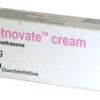Dosage Forms and Strengths
Fucidin is available primarily as a topical cream or ointment, containing the active ingredient fusidic acid. These formulations typically contain fusidic acid at a concentration of 2%. Package sizes vary, catering to different patient needs, including smaller tubes ideal for minor skin conditions.
Mechanism of Action
Fucidin works by inhibiting bacterial protein synthesis, thereby preventing bacterial growth and replication. This mechanism is facilitated by targeting the bacterial ribosome, interfering with the translation phase of protein synthesis. This action effectively combats susceptible strains of Staphylococcus aureus and other gram-positive organisms.
Therapeutic Indications
Fucidin is indicated for the treatment of bacterial skin infections, particularly those caused by Staphylococcus aureus. Common conditions treated include impetigo, infected wounds, and folliculitis. It may also be used as an adjunct therapy in other dermatological conditions involving bacterial superinfection.
Pharmacokinetic Profile
Fucidin exhibits limited systemic absorption when applied topically, which minimizes systemic side effects. The absorption rate may vary depending on the area of application and condition of the skin. Fusidic acid is primarily metabolized in the liver and eliminated through the bile.
Administration Instructions
For effective application, the affected area should be cleaned and dried prior to applying a thin layer of Fucidin. The application is usually recommended two to three times daily unless otherwise directed by a healthcare provider. It is important to cover the treated area with a dressing only if advised.
Potential Drug Interactions
Fucidin exhibits low potential for systemic drug interactions due to its minimal systemic absorption. However, caution is advised when used with other topical agents to prevent altered effects. Consulting a healthcare provider when using other topical medications concurrently is recommended.
Adverse Reactions and Side Effects
Common side effects include mild irritation, such as itching or redness at the site of application. In rare instances, contact dermatitis or systemic allergic reactions may occur. It is imperative to discontinue use and seek medical advice if severe allergic reactions or skin rash develop.
Contraindications and Precautions
Fucidin should not be used in patients with known hypersensitivity to fusidic acid or any component of the formulation. It should be used with caution in cases of extensive skin lesions where significant absorption might occur. Avoid ocular application or applying them near mucosal surfaces.
Fucidin Storage Conditions
Store Fucidin in a cool, dry place away from direct sunlight. Exposure to excessive heat may degrade the active ingredient and reduce efficacy. Ensure the packaging is tightly sealed to prevent contamination. Keep out of reach of children to prevent accidental ingestion.
Fucidin in Special Populations
Caution is advised when using Fucidin in pregnant or breastfeeding women, although systemic absorption is low. Pediatric use should be guided by a healthcare provider. In elderly patients, standard application procedures are generally applicable barring any specific contraindications.
Impact on Lab Tests
Using Fucidin topically is not known to interfere with laboratory tests as systemic absorption is minimal. However, if extensive use leads to bacterial resistance, susceptibility testing may be recommended for diagnosing persistent infections. Inform lab personnel regarding its use if undergoing skin-specific diagnostics.
Resistance Considerations
Overuse or misuse of Fucidin may contribute to the development of antibiotic-resistant bacteria, particularly in staphylococcal strains. Adhering to recommended treatment durations and dosages helps mitigate this risk. Alternating with or combining other classes of antimicrobials may be advised in resistant cases.








Reviews
There are no reviews yet.